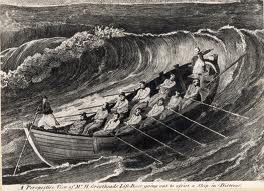n
n
n
n
nOnenday in 1789, a British ship was stranded on a sandbank. Thenconditions were so stormy that the crew could not be rescued—andnthat’s no good! A committee formed to design and build a special boatnthat could deal with such a situation, in the future. It would bencalled a lifeboat.
n
n
n
n
n
n Anman named Henry Greathead designed a lifeboat but was apparentlynemployed to build a lifeboat designed by the committee with some ofnhis suggestions. The lifeboat had a curved keel that rose higher thannmost boats—the better to deal with the high waves of a storm. Itncould be rowed in either direction and could be steered by oar rathernthan by rudder. The sides were cased with four-inch-thick cork,ncovered with copper; the cork helped the boat be extremely buoyantnand able to recover quickly from being upset. n
Anman named Henry Greathead designed a lifeboat but was apparentlynemployed to build a lifeboat designed by the committee with some ofnhis suggestions. The lifeboat had a curved keel that rose higher thannmost boats—the better to deal with the high waves of a storm. Itncould be rowed in either direction and could be steered by oar rathernthan by rudder. The sides were cased with four-inch-thick cork,ncovered with copper; the cork helped the boat be extremely buoyantnand able to recover quickly from being upset. n
 Anman named Henry Greathead designed a lifeboat but was apparentlynemployed to build a lifeboat designed by the committee with some ofnhis suggestions. The lifeboat had a curved keel that rose higher thannmost boats—the better to deal with the high waves of a storm. Itncould be rowed in either direction and could be steered by oar rathernthan by rudder. The sides were cased with four-inch-thick cork,ncovered with copper; the cork helped the boat be extremely buoyantnand able to recover quickly from being upset. n
Anman named Henry Greathead designed a lifeboat but was apparentlynemployed to build a lifeboat designed by the committee with some ofnhis suggestions. The lifeboat had a curved keel that rose higher thannmost boats—the better to deal with the high waves of a storm. Itncould be rowed in either direction and could be steered by oar rathernthan by rudder. The sides were cased with four-inch-thick cork,ncovered with copper; the cork helped the boat be extremely buoyantnand able to recover quickly from being upset. nn
n
n
n
n
nThenlifeboat, called the Original, was able to carry twelvenpeople. On this day in 1790, she went on her first trial. It wasnquite successful and remained in service for 40 years.
n
n
n
n
n
nNoticenthat the Original was not carried about on a ship but wasninstead kept in a harbor. She went to sea whenever a ship signaledndistress.
n
n
n
n
n
n Nowadaysnmany large ships carry their own lifeboats onboard, and manynlifeboats are inflatable. There are still many harbor-based lifeboatsnthat are designed to be very speedy, to hold extra fuel reserves, andnto stay afloat in bad weather. Of course up-to-date lifeboats usenmodern communication and data technologies to find ships and othernwatercraft in distress and to locate and rescue survivors.
Nowadaysnmany large ships carry their own lifeboats onboard, and manynlifeboats are inflatable. There are still many harbor-based lifeboatsnthat are designed to be very speedy, to hold extra fuel reserves, andnto stay afloat in bad weather. Of course up-to-date lifeboats usenmodern communication and data technologies to find ships and othernwatercraft in distress and to locate and rescue survivors.
 Nowadaysnmany large ships carry their own lifeboats onboard, and manynlifeboats are inflatable. There are still many harbor-based lifeboatsnthat are designed to be very speedy, to hold extra fuel reserves, andnto stay afloat in bad weather. Of course up-to-date lifeboats usenmodern communication and data technologies to find ships and othernwatercraft in distress and to locate and rescue survivors.
Nowadaysnmany large ships carry their own lifeboats onboard, and manynlifeboats are inflatable. There are still many harbor-based lifeboatsnthat are designed to be very speedy, to hold extra fuel reserves, andnto stay afloat in bad weather. Of course up-to-date lifeboats usenmodern communication and data technologies to find ships and othernwatercraft in distress and to locate and rescue survivors.n
n
n
n
n
nAlsonon this date:
n
n
n
n
n
n
nBubble Wrap Appreciation Day
n
n
n
n
n
n
n
n
n
n
n
n
n
n
nBirthdaynof Thomas Rolfe, son of Pocahontas
nn
n
n
n
n
n
n
n
n
n
n
n
n
n
n
n
n
n
n
n
n
n
n
nAnniversarynof the discovery of the world’s tallest geyser
nn
n
n
n
n
nn























